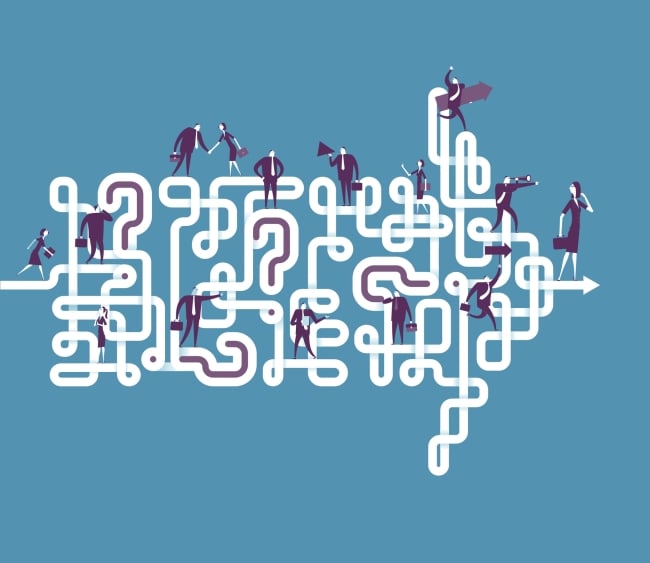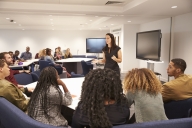You have /5 articles left.
Sign up for a free account or log in.

Students may see credit for prior learning as requiring time and money they don’t have for an uncertain reward.
akindo/DigitalVisionVectors/Getty Images
Too often, equity in education can seem unachievable, with efforts like completion grants appearing to have minimal impact. While adult-serving programs are engines of equity, COVID, budget shortfalls and personnel cuts have left them stretched. Nevertheless, the demographic dip has put many at the center of their institution’s survival plans—but rarely with a commensurate infusion of resources to attract and retain more adults.
Conceptualized over 50 years ago, credit for prior learning (CPL or PLA) has proven to be a valuable tool for recruiting, retaining and graduating adults. It is a unique win-win-win that makes business sense for institutions, reduces time and cost for learners, and leads to further learning.
That said, the equity paradox of CPL is that it has the greatest potential to increase persistence and degree completion for those least likely to use it. Nationally, 80 percent of institutions offer CPL, but only 11 percent of adults at these institutions earned CPL. Black and low-income adults are the most likely to benefit from, but the least likely to earn, CPL. This shortfall is not because their CPL applications fail, but because they are not accessing CPL in the first place.
Credit for prior learning—the recognition of college-level learning gained in personal and professional pursuits—can result in more adult students and more equitable outcomes. Not, however, as it is commonly practiced. Making CPL programs work for all is not hard, but it does require new approaches.
CPL dangles the promise but very rarely provides a means for recognizing and so accelerating the learning of those who return to school rich in experience but not credit hours.
It does not have to be this way.
After years of limited success increasing CPL uptake, I had the opportunity to rebuild a CPL program at College Unbound (CU), a college serving those least likely to earn CPL. In three years, we tripled the percentage of enrolled students earning CPL. By last August, 96 percent of all graduates had earned CPL.
While I’d like to say that I knew from the start how to achieve these results, or even that they were possible, that was far from the case. As a professor, I had often failed to convince students to try CPL. They saw it as requiring time and money they didn’t have for an uncertain reward—uncertain because CPL was yet another novel challenge for adults trying to adapt to multiple changes in their lives, in how school works and in their understanding of themselves as learners. Research (including in the journal Prior Learning Assessment Inside Out, this article and this one, as well as this article in the Journal of Continuing Education) demonstrates how class and race-based biases skew what both schools and students themselves recognize as creditworthy learning.
I did not fully appreciate the inequity in these missed opportunities until I began a longitudinal study following the higher education learning journeys of 25 adult undergraduates.
While more Black than white students graduated, they took over twice as long to do so. Black students stopped out more often to work and care for family members. Despite this additional life experience, they were less likely to earn CPL credit. By the time they finished, the average age of the Black graduates was 51, leaving them with 13.5 fewer years of bachelor’s-level earning power than the white graduates. This extended time to degree serves as “a mechanism for the reproduction of inequality.”
In a much larger study of 1,971 women at the City University of New York, Black and Hispanic women averaged three to four years longer than their white peers to earn bachelor’s degrees.
A recent Gallup-Lumina study found that “Black bachelor’s students are twice as likely as other bachelor’s students to have additional responsibilities as caregivers or full-time workers.”
Higher education that asserts a commitment to equity must recognize and credit the learning from these additional responsibilities rather than regarding them as distractions.
We were able to do so at CU by starting from the experiences of our students using these four approaches.
1. Designing with, rather than for, adult learners.
This means going beyond intermittent sampling of student input through surveys or focus groups. At CU, I offered this course in which students researched CPL and proposed a plan that guided the college’s CPL program development. Their input kept us grounded in the realities of students’ lives and built support for CPL across the institution.
Interviews with students revealed that most had acquired significant learning as a result of experiences that included being caregivers and multilingual workers. Using questions refined in these interviews, I designed templates for documenting and reflecting upon their learning. These templates, which became available in January 2022, accounted for over a quarter of the CPL awarded at CU in the first half of 2022.
Designing CPL for the learning adults bring from their lives leads to more equitable outcomes. For example, while many colleges offer CPL for high scores on the Advanced Placement and International Baccalaureate tests that well-funded high schools prepare their students to take, fewer than 1 percent of 232,622 adults earned CPL with AP or IB. Working inductively from students’ learning experiences helps avoid unconscious bias about what is and is not creditworthy.
2. Borrowing from design thinking to accomplish big changes with manageable steps while minimizing missteps.
We used pilots to prototype, evaluate and iterate before asking stakeholders to approve a final design. Every aspect of the CU program took several iterations. Upon evaluating the interview-based protocol described in this article, we realized that it was not scalable. However, the interviews allowed us to identify credentials to assess for credit and to create the templates described above. As a result, we more than doubled the number of students earning CPL in one year.
Small fixes led to unintended benefits. For example, I assigned this request form because students were reluctant to ask for feedback on their strengths. After managers completed the form, students reported being invited to participate on committees and offered leadership opportunities, and a few received promotions. The assignment not only helped students recognize their own strengths, it also raised their profile at work.
3. Requiring it.
Since fall 2019, the completion of 10 CPL portfolios demonstrating CU’s Big 10 Leadership & Change Competencies has been a graduation requirement. While most CPL credits earned at CU are not from these required portfolios, they introduce students to CPL.
It may seem unrealistic to require CPL. To be sure, many students do not have experiential learning that matches course requirements. However, every adult, particularly those who have the wherewithal to return to college, will have had at least some life learning relevant to the transferable knowledge and skills sometimes called essential learning outcomes, transferable skills or 21st-century skills and articulated in tools such as EdDesign Lab’s microcredentials and AAC&U’s VALUE rubrics. Consider, for example, the creative problem-solving of the single mother who transformed her apartment into a school, work and play space in a week due to COVID shutdowns, or the critical thinking required to make informed decisions about mask wearing.
These essential outcomes frequently appear in general education and programmatic degree requirements. In the journal New Directions for Teaching & Learning, researchers argued that colleges can use CPL to engage learners in an initial assessment of these outcomes, awarding credit when warranted.
4. And—hardest of all—checking assumptions.
I was an intellectual snob from a young age despite, or, more likely, because I grew up in a financially precarious household with parents who did not complete college. My education served to reinforce my biases. By the time I earned my Ph.D., I assumed that, with a few exceptions, intelligence tracked not only with degree attainment, but also with where the degree was earned; that those who did not complete college in four years were probably not cut out for it; and that working-class and service-sector jobs were for people who did not have the intellectual capacity for higher education.
Fortunately, I spent over three decades learning about and from the immense reserves of intelligence, creativity and critical awareness of adult students. I would not have been capable of conceptualizing the changes described here if I had not learned to set aside assumptions, recognize biases and, most importantly, listen to students tell their stories.
Certainly, developing a strong, equitable CPL program does not happen overnight. It took three years to put in place the innovations described here. While I had limited resources, CU’s small size and start-up culture gave me flexibility that I did not have at other institutions. However, I now realize how much more I could have accomplished had I understood what was possible.








